Question
A chocolate bar has the shape of a triangular right prism ABCDEF as shown in the diagram. The ends are equilateral triangles of side 6 cm and the length of the chocolate bar is 23 cm.
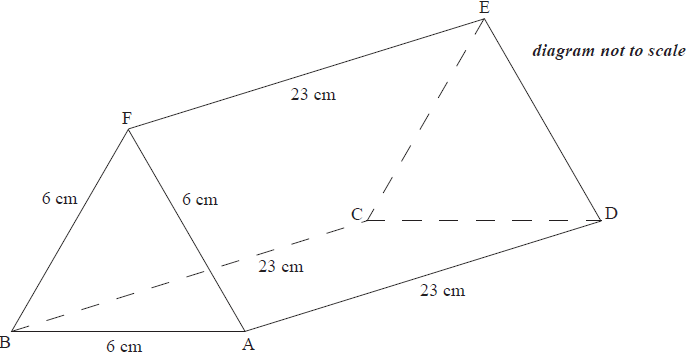
Write down the size of angle BAF.[1]
Hence or otherwise find the area of the triangular end of the chocolate bar.[3]
Find the total surface area of the chocolate bar.[3]
It is known that 1 cm3 of this chocolate weighs 1.5 g. Calculate the weight of the chocolate bar.[3]
A different chocolate bar made with the same mixture also has the shape of a triangular prism. The ends are triangles with sides of length 4 cm, 6 cm and 7 cm.
Show that the size of the angle between the sides of 6 cm and 4 cm is 86.4° correct to 3 significant figures.[3]
The weight of this chocolate bar is 500 g. Find its length.[4]
Answer/Explanation
Markscheme
60° (A1)[1 mark]
Unit penalty (UP) applies in this part
\({\text{Area}} = \frac{{6 \times 6 \times \sin 60^\circ }}{2}\) (M1)(A1)
(UP) = 15.6 cm2 \((9 \sqrt{3})\) (A1)(ft)(G2)
Note: Award (M1) for substitution into correct formula, (A1) for correct values. Accept alternative correct methods.[3 marks]
Unit penalty (UP) applies in this part
\({\text{Surface Area}} =15.58 \times 2 + 23 \times 6 \times 3\) (M1)(M1)
Note: Award (M1) for two terms with 2 and 3 respectively, (M1) for \(23 \times 6\) (138).
(UP) Surface Area = 445 cm2 (A1)(ft)(G2)[3 marks]
Unit penalty (UP) applies in this part
\({\text{weight}} = 1.5 \times 15.59 \times 23\) (M1)(M1)
Note: Award (M1) for finding the volume, (M1) for multiplying their volume by 1.5.
(UP) weight = 538 g (A1)(ft)(G3)[3 marks]
\(\cos \alpha = \frac{{{4^2} + {6^2} – {7^2}}}{{2 \times 4 \times 6}}\) (M1)(A1)
Note: Award (M1) for using cosine rule with values from the problem, (A1) for correct substitution.
\(\alpha = 86.41…\) (A1)
\(\alpha = 86.4^{\circ}\) (AG)
Note: 86.41… must be seen for final (A1) to be awarded.[3 marks]
Unit penalty (UP) applies in this part
\(l \times \frac{{4 \times 6 \times \sin 86.4^\circ }}{2} \times 1.5 = 500\) (M1)(A1)(M1)
Notes: Award (M1) for finding an expression for the volume, (A1) for correct substitution, (M1) for multiplying the volume by 1.5 and equating to 500, or for equating the volume to \(\frac{500}{1.5}\).
If formula for volume is not correct but consistent with that in (c) award at most (M1)(A0)(ft)(M1)(A0).
(UP) l = 27.8 cm (A1)(G3)[4 marks]
Question
A farmer has a triangular field, ABC, as shown in the diagram.
AB = 35 m, BC = 80 m and BÂC = 105°, and D is the midpoint of BC.

Find the size of BĈA.[3]
Calculate the length of AD.[5]
The farmer wants to build a fence around ABD.
Calculate the total length of the fence.[2]
The farmer wants to build a fence around ABD.
The farmer pays 802.50 USD for the fence. Find the cost per metre.[2]
Calculate the area of the triangle ABD.[3]
A layer of earth 3 cm thick is removed from ABD. Find the volume removed in cubic metres.[3]
Answer/Explanation
Markscheme
\(\frac{{\sin {\text{BCA}}}}{{35}} = \frac{{\sin 105^\circ }}{{80}}\) (M1)(A1)
Note: Award (M1) for correct substituted formula, (A1) for correct substitutions.
\({\text{B}}{\operatorname{\hat C}}{\text{A}} = 25.0^{\circ}\) (A1)(G2)[3 marks]
Note: Unit penalty (UP) applies in parts (b)(c) and (e)
Length BD = 40 m (A1)
Angle ABC = 180° − 105° − 25° = 50° (A1)(ft)
Note: (ft) from their answer to (a).
AD2 = 352 + 402 − (2 × 35 × 40 × cos 50°) (M1)(A1)(ft)
Note: Award (M1) for correct substituted formula, (A1)(ft) for correct substitutions.
(UP) AD = 32.0 m (A1)(ft)(G3)
Notes: If 80 is used for BD award at most (A0)(A1)(ft)(M1)(A1)(ft)(A1)(ft) for an answer of 63.4 m.
If the angle ABC is incorrectly calculated in this part award at most (A1)(A0)(M1)(A1)(ft)(A1)(ft).
If angle BCA is used award at most (A1)(A0)(M1)(A0)(A0).[5 marks]
Note: Unit penalty (UP) applies in parts (b)(c) and (e)
length of fence = 35 + 40 + 32 (M1)
(UP) = 107 m (A1)(ft)(G2)
Note: (M1) for adding 35 + 40 + their (b).[2 marks]
cost per metre \( = \frac{802.50}{107}\) (M1)
Note: Award (M1) for dividing 802.50 by their (c).
cost per metre = 7.50 USD (7.5 USD) (USD not required) (A1)(ft)(G2)[2 marks]
Note: Unit penalty (UP) applies in parts (b)(c) and (e)
Area of ABD \( = \frac{1}{2} \times 35 \times 40 \times \sin 50^\circ \) (M1)
= 536.2311102 (A1)(ft)
(UP) = 536 m2 (A1)(ft)(G2)
Note: Award (M1) for correct substituted formula, (A1)(ft) for correct substitution, (ft) from their value of BD and their angle ABC in (b).[3 marks]
Volume = 0.03 × 536 (A1)(M1)
= 16.08
= 16.1 (A1)(ft)(G2)
Note: Award (A1) for 0.03, (M1) for correct formula. (ft) from their (e).
If 3 is used award at most (A0)(M1)(A0).[3 marks]
Question
The diagram shows an office tower of total height 126 metres. It consists of a square based pyramid VABCD on top of a cuboid ABCDPQRS.
V is directly above the centre of the base of the office tower.
The length of the sloping edge VC is 22.5 metres and the angle that VC makes with the base ABCD (angle VCA) is 53.1°.
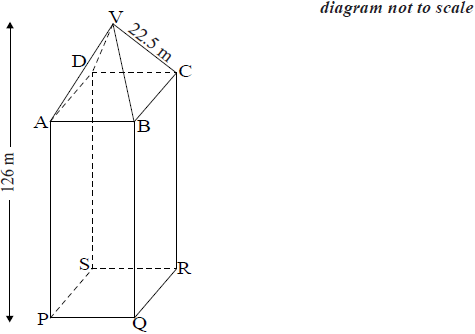
Write down the length of VA in metres.[1]
Sketch the triangle VCA showing clearly the length of VC and the size of angle VCA.[1]
Show that the height of the pyramid is 18.0 metres correct to 3 significant figures.[2]
Calculate the length of AC in metres.[3]
Show that the length of BC is 19.1 metres correct to 3 significant figures.[2]
Calculate the volume of the tower.[4]
To calculate the cost of air conditioning, engineers must estimate the weight of air in the tower. They estimate that 90 % of the volume of the tower is occupied by air and they know that 1 m3 of air weighs 1.2 kg.
Calculate the weight of air in the tower.[3]
Answer/Explanation
Markscheme
22.5 (m) (A1)[1 mark]
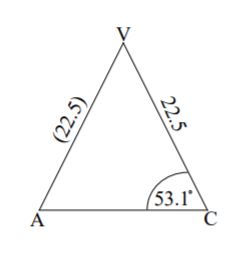 (A1)[1 mark]
(A1)[1 mark]
h = 22.5 sin 53.1° (M1)
= 17.99 (A1)
= 18.0 (AG)
Note: Unrounded answer must be seen for (A1) to be awarded.
Accept 18 as (AG).[2 marks]
\({\text{AC}} = 2\sqrt {{{22.5}^2} – {{17.99…}^2}} \) (M1)(M1)
Note: Award (M1) for multiplying by 2, (M1) for correct substitution into formula.
OR
AC = 2(22.5)cos53.1° (M1)(M1)
Notes: Award (M1) for correct use of cosine trig ratio, (M1) for multiplying by 2.
OR
AC2 = 22.52 + 22.52 – 2(22.5)(22.5) cos73.8° (M1)(A1)
Note: Award (M1) for substituted cosine formula, (A1) for correct substitutions.
OR
\(\frac{{{\text{AC}}}}{{\sin (73.8^\circ )}} = \frac{{22.5}}{{\sin (53.1^\circ )}}\) (M1)(A1)
Note: Award (M1) for substituted sine formula, (A1) for correct substitutions.
AC = 27.0 (A1)(G2)[3 marks]
\({\text{BC}} = \sqrt {{{13.5}^2} + {{13.5}^2}} \) (M1)
= 19.09 (A1)
= 19.1 (AG)
OR
x2 + x2 = 272 (M1)
2x2 = 272 (A1)
BC = 19.09… (A1)
= 19.1 (AG)
Notes: Unrounded answer must be seen for (A1) to be awarded.[2 marks]
Volume = Pyramid + Cuboid
\( = \frac{1}{3}(18)({19.1^2}) + (108)({19.1^2})\) (A1)(M1)(M1)
Note: Award (A1) for 108, the height of the cuboid seen. Award (M1) for correctly substituted volume of cuboid and (M1) for correctly substituted volume of pyramid.
= \(41\,588\) (41\(\,\)553 if 2(13.52) is used)
= \(41\,600\) m3 (A1)(ft)(G3)[4 marks]
Weight of air = \(41\,600 \times 1.2 \times 0.9\) (M1)(M1)
= \(44\,900{\text{ kg}}\) (A1)(ft)(G2)
Note: Award (M1) for their part (e) × 1.2, (M1) for × 0.9.
Award at most (M1)(M1)(A0) if the volume of the cuboid is used.[3 marks]
Question
A gardener has to pave a rectangular area 15.4 metres long and 5.5 metres wide using rectangular bricks. The bricks are 22 cm long and 11 cm wide.
The gardener decides to have a triangular lawn ABC, instead of paving, in the middle of the rectangular area, as shown in the diagram below.
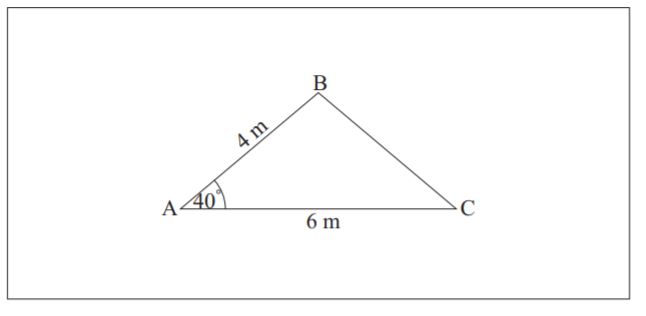
The distance AB is 4 metres, AC is 6 metres and angle BAC is 40°.
In another garden, twelve of the same rectangular bricks are to be used to make an edge around a small garden bed as shown in the diagrams below. FH is the length of a brick and C is the centre of the garden bed. M and N are the midpoints of the long edges of the bricks on opposite sides of the garden bed.
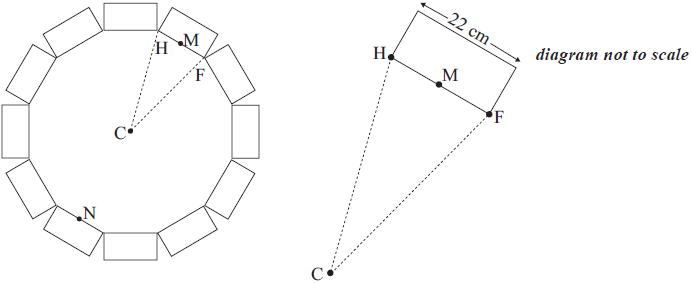
The garden bed has an area of 5419 cm2. It is covered with soil to a depth of 2.5 cm.
It is estimated that 1 kilogram of soil occupies 514 cm3.
Calculate the total area to be paved. Give your answer in cm2.[3]
Write down the area of each brick.[1]
Find how many bricks are required to pave the total area.[2]
Find the length of BC.[3]
Hence write down the perimeter of the triangular lawn.[1]
Calculate the area of the lawn.[2]
Find the percentage of the rectangular area which is to be lawn.[3]
Find the angle FCH.[2]
Calculate the distance MN from one side of the garden bed to the other, passing through C.[3]
Find the volume of soil used.[2]
Find the number of kilograms of soil required for this garden bed.[2]
Answer/Explanation
Markscheme
15.4 × 5.5 (M1)
84.7 m2 (A1)
= 847000 cm2 (A1)(G3)
Note: Award (G2) if 84.7 m2 seen with no working.
OR
1540 × 550 (A1)(M1)
= 847000 cm2 (A1)(ft)(G3)
Note: Award (A1) for both dimensions converted correctly to cm, (M1) for multiplication of both dimensions. (A1)(ft) for correct product of their sides in cm.[3 marks]
242 cm2 (0.0242 m2) (A1)[1 marks}
\(\frac {15.4}{0.22} = 70\) (M1)
\(\frac{5.5}{0.11} = 50\)
\(70 \times 50 = 3500\) (A1)(G2)
OR
\(\frac {847000}{242} = 3500\) (M1)(A1)(ft)(G2)
Note: Follow through from parts (a) (i) and (ii).[2 marks]
\({\text{B}}{{\text{C}}^2} = {4^2} + {6^2}-2 \times 4 \times 6 \times \cos 40^\circ \) (M1)(A1)
\({\text{BC}} = 3.90{\text{ m}}\) (A1)(G2)
Note: Award (M1) for correct substituted formula, (A1) for correct substitutions, (A1) for correct answer.[3 marks]
perimeter = 13.9 m (A1)(ft)(G1)
Notes: Follow through from part (b) (i).[1 mark]
\({\text{Area}} = \frac{1}{2} \times 4 \times 6 \times \sin 40^\circ \) (M1)
= 7.71 m2 (A1)(ft)(G2)
Notes: Award (M1) for correct formula and correct substitution, (A1)(ft) for correct answer.[2 marks]
\(\frac{{7.713}}{{84.7}} \times 100{\text{ }}\% = 9.11{\text{ }}\% \) (A1)(M1)(A1)(ft)(G2)
Notes: Accept 9.10 %.
Award (A1) for both measurements correctly written in the same unit, (M1) for correct method, (A1)(ft) for correct answer.
Follow through from (b) (iii) and from consistent error in conversion of units throughout the question.[3 marks]
\(\frac{{360^\circ }}{{12}}\) (M1)
\( = 30^\circ\) (A1)(G2)[2 marks]
\(\text{MN} = 2 \times \frac{11}{\tan 15} \) (A1)(ft)(M1)
OR
\(\text{MN} = 2 \times 11 \tan 75^\circ \)
\({\text{MN}} = 82.1{\text{ cm}}\) (A1)(ft)(G2)
Notes: Award (A1) for 11 and 2 seen (implied by 22 seen), (M1) for dividing by tan15 (or multiplying by tan 75).
Follow through from their angle in part (c) (i).[3 marks]
volume = 5419 × 2.5 (M1)
= 13500 cm3 (A1)(G2)[2 marks]
\(\frac{{13547.34 \ldots }}{{514}} = 26.4\) (M1)(A1)(ft)(G2)
Note: Award (M1) for dividing their part (d) by 514.
Accept 26.3.[2 marks]
Question
Part A
100 students are asked what they had for breakfast on a particular morning. There were three choices: cereal (X) , bread (Y) and fruit (Z). It is found that
10 students had all three
17 students had bread and fruit only
15 students had cereal and fruit only
12 students had cereal and bread only
13 students had only bread
8 students had only cereal
9 students had only fruit
Part B
The same 100 students are also asked how many meals on average they have per day. The data collected is organized in the following table.

A \({\chi ^2}\) test is carried out at the 5 % level of significance.
Represent this information on a Venn diagram.[4]
Find the number of students who had none of the three choices for breakfast.[2]
Write down the percentage of students who had fruit for breakfast.[2]
Describe in words what the students in the set \(X \cap Y’\) had for breakfast.[2]
Find the probability that a student had at least two of the three choices for breakfast.[2]
Two students are chosen at random. Find the probability that both students had all three choices for breakfast.[3]
Write down the null hypothesis, H0, for this test.[1]
Write down the number of degrees of freedom for this test.[1]
Write down the critical value for this test.[1]
Show that the expected number of females that have more than 5 meals per day is 13, correct to the nearest integer.[2]
Use your graphic display calculator to find the \(\chi _{calc}^2\) for this data.[2]
Decide whether H0 must be accepted. Justify your answer.[2]
Answer/Explanation
Markscheme
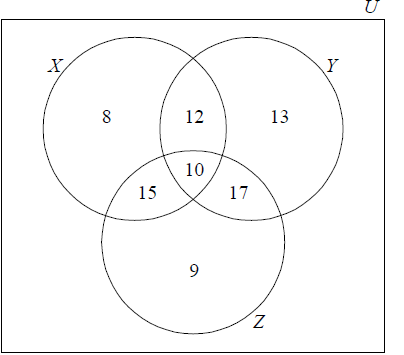
(A1) for rectangle and three intersecting circles
(A1) for 10, (A1) for 8, 13 and 9, (A1) for 12, 15 and 17 (A4)[4 marks]
100 – (9 +12 +13 +15 +10 +17 + 8) =16 (M1)(A1)(ft)(G2)
Note: Follow through from their diagram.[2 marks]
\(\frac{{51}}{{100}}(0.51)\) (A1)(ft)
= 51% (A1)(ft)(G2)
Note: Follow through from their diagram.[2 marks]
Note: The following statements are correct. Please note that the connectives are important. It is not the same (had cereal) and (not bread) and (had cereal) or (not bread). The parentheses are not needed but are there to facilitate the understanding of the propositions.
(had cereal) and (did not have bread)
(had cereal only) or (had cereal and fruit only)
(had either cereal or (fruit and cereal)) and (did not have bread) (A1)(A1)
Notes: If the statements are correct but the connectives are wrong then award at most (A1)(A0). For the statement (had only cereal) and (cereal and fruit) award (A1)(A0). For the statement had cereal and fruit award (A0)(A0).[2 marks]
\(\frac{{54}}{{100}}(0.54,{\text{ 54 % }})\) (A1)(ft)(A1)(ft)(G2)
Note: Award (A1)(ft) for numerator, follow through from their diagram, (A1)(ft) for denominator. Follow through from total or denominator used in part (c).[2 marks]
\(\frac{{10}}{{100}} \times \frac{9}{{99}} = \frac{1}{{110}}(0.00909,{\text{ 0}}{\text{.909 % }})\) (A1)(ft)(M1)(A1)(ft)(G2)
Notes: Award (A1)(ft) for their correct fractions, (M1) for multiplying two fractions, (A1)(ft) for their correct answer. Answer 0.009 with no working receives no marks. Follow through from denominator in parts (c) and (e) and from their diagram.[3 marks]
H0 : The (average) number of meals per day a student has and gender are independent (A1)
Note: For “independent” accept “not associated” but do not accept “not related” or “not correlated”.[1 mark]
2 (A1)[1 mark]
5.99 (accept 5.991) (A1)(ft)
Note: Follow through from their part (b).[1 mark]
\(\frac{{28 \times 45}}{{100}} = 12.6 = 13\) or \(\frac{{28}}{{100}} \times \frac{{25}}{{100}} \times 100 = 12.6 = 13\) (M1)(A1)(AG)
Notes: Award (M1) for correct formula and (A1) for correct substitution. Unrounded answer must be seen for the (A1) to be awarded.[2 marks]
0.0321 (G2)
Note: For 0.032 award (G1)(G1)(AP). For 0.03 with no working award (G0).[2 marks]
0.0321 < 5.99 or 0.984 > 0.05 (R1)
accept H0 (A1)(ft)
Note: If reason is incorrect both marks are lost, do not award (R0)(A1).[2 marks]
Question
Cedric wants to buy an €8000 car. The car salesman offers him a loan repayment option of a 25 % deposit followed by 12 equal monthly payments of €600 .
Write down the amount of the deposit.[1]
Calculate the total cost of the loan under this repayment scheme.[2]
Cedric’s mother decides to help him by giving him an interest free loan of €8000 to buy the car. She arranges for him to repay the loan by paying her €x in the first month and €y in every following month until the €8000 is repaid.
The total amount that Cedric’s mother receives after 12 months is €3500. This can be written using the equation x +11y = 3500. The total amount that Cedric’s mother receives after 24 months is €7100.
Write down a second equation involving x and y.[1]
Cedric’s mother decides to help him by giving him an interest free loan of €8000 to buy the car. She arranges for him to repay the loan by paying her €x in the first month and €y in every following month until the €8000 is repaid.
The total amount that Cedric’s mother receives after 12 months is €3500. This can be written using the equation x +11y = 3500. The total amount that Cedric’s mother receives after 24 months is €7100.
Write down the value of x and the value of y.[2]
Cedric’s mother decides to help him by giving him an interest free loan of €8000 to buy the car. She arranges for him to repay the loan by paying her €x in the first month and €y in every following month until the €8000 is repaid.
The total amount that Cedric’s mother receives after 12 months is €3500. This can be written using the equation x +11y = 3500. The total amount that Cedric’s mother receives after 24 months is €7100.
Calculate the number of months it will take Cedric’s mother to receive the €8000.[3]
Cedric decides to buy a cheaper car for €6000 and invests the remaining €2000 at his bank. The bank offers two investment options over three years.
Option A: Compound interest at an annual rate of 8 %.
Option B: Compound interest at a nominal annual rate of 7.5 % , compounded monthly.
Express each answer in part (f) to the nearest euro.
Calculate the value of his investment at the end of three years if he chooses
(i) Option A;
(ii) Option B.[5]
Answer/Explanation
Markscheme
2000 (euros) (A1)[1 mark]
\(2000 + 12 \times 600\) (M1)
Note: Award (M1) for addition of two correct terms.
9200 (euros) (A1)(ft)(G2)
Note: Follow through from their part (a).[2 marks]
x + 23y = 7100 (A1)[1 mark]
x = 200, y = 300 (A1)(ft)(A1)(ft)(G2)[2 marks]
\(200 + n \times 300 = 8000\) (M1)
Note: Award (M1) for setting up the equation. Follow through from their x and y found in part (d).
n = 26 (A1)(ft)
26 + 1 = 27 (months) (A1)(ft)(G3)
Notes: Middle line n = 26 may be implied if correct answer given. The final (A1)(ft) is for adding 1 to their value of n (even if it is incorrect). Follow through from their part (d). If the final answer is not a positive integer award at most (M1)(A1)(ft)(A0). Award (G2) for final answer of 26.
OR
\(\frac{{8000 – 7100}}{{300}} + 24\) (M1)(A1)
Note: Award (M1) for division of difference by their value of y, (A1) for 24 seen.
27 (months) (A1)(ft)(G3)
Note: Follow through from their value of y.[3 marks]
(i) \(2000{\left( {1 + \frac{8}{{100}}} \right)^3}\) (M1)
Note: Award (M1) for correct substitution in compound interest formula.2519 (euros) (A1)(G2)
Note: If the answer is not given to the nearest euro award at most (M1)(A0).(ii) \(2000{\left( {1 + \frac{7.5}{{100 \times 12}}} \right)^{3\times12}}\) (M1)(A1)
Note: Award (M1) for substitution in compound interest formula, (A1) for correct substitutions.
2503 (euros) (A1)(G2)
Note: If the answer is not given to the nearest euro, award at most (M1)(A1)(A0), provided this has not been penalized in part (f)(i).[5 marks]
Question
The front view of the edge of a water tank is drawn on a set of axes shown below.
The edge is modelled by \(y = a{x^2} + c\).
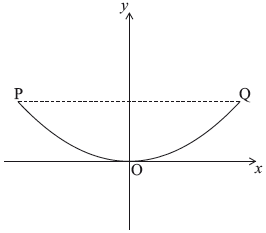
Point \({\text{P}}\) has coordinates \((-3, 1.8)\), point \({\text{O}}\) has coordinates \((0, 0)\) and point \({\text{Q}}\) has coordinates \((3, 1.8)\).
Write down the value of \(c\).[1]
Find the value of \(a\).[2]
Hence write down the equation of the quadratic function which models the edge of the water tank.[1]
The water tank is shown below. It is partially filled with water.
Calculate the value of y when \(x = 2.4{\text{ m}}\).[2]
The water tank is shown below. It is partially filled with water.
State what the value of \(x\) and the value of \(y\) represent for this water tank.[2]
The water tank is shown below. It is partially filled with water.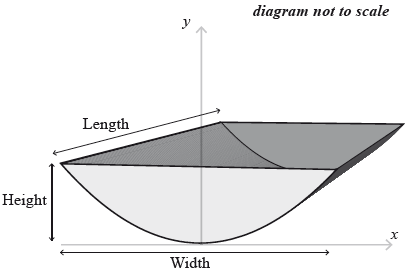
Find the value of \(x\) when the height of water in the tank is \(0.9\) m.[2]
The water tank is shown below. It is partially filled with water.
The water tank has a length of 5 m.
When the water tank is filled to a height of \(0.9\) m, the front cross-sectional area of the water is \({\text{2.55 }}{{\text{m}}^2}\).
(i) Calculate the volume of water in the tank.
The total volume of the tank is \({\text{36 }}{{\text{m}}^3}\).
(ii) Calculate the percentage of water in the tank.[2]
Answer/Explanation
Markscheme
\(0\) (A1)(G1)[1 mark]
\(1.8 = a{(3)^2} + 0\) (M1)
OR
\(1.8 = a{( – 3)^2} + 0\) (M1)
Note: Award (M1) for substitution of \(y = 1.8\) or \(x = 3\) and their value of \(c\) into equation. \(0\) may be implied.
\(a = 0.2\) \(\left( {\frac{1}{5}} \right)\) (A1)(ft)(G1)
Note: Follow through from their answer to part (a).
Award (G1) for a correct answer only.[2 marks]
\(y = 0.2{x^2}\) (A1)(ft)
Note: Follow through from their answers to parts (a) and (b).
Answer must be an equation.[1 mark]
\(0.2 \times {(2.4)^2}\) (M1)
\( = 1.15{\text{ (m)}}\) \((1.152)\) (A1)(ft)(G1)
Notes: Award (M1) for correctly substituted formula, (A1) for correct answer. Follow through from their answer to part (c).
Award (G1) for a correct answer only.[2 marks]
\(y\) is the height (A1)
positive value of \(x\) is half the width (or equivalent) (A1)[2 marks]
\(0.9 = 0.2{x^2}\) (M1)
Note: Award (M1) for setting their equation equal to \(0.9\).
\(x = \pm 2.12{\text{ (m)}}\) \(\left( { \pm \frac{3}{2}\sqrt 2 ,{\text{ }} \pm \sqrt {4.5} ,{\text{ }} \pm {\text{2.12132}} \ldots } \right)\) (A1)(ft)(G1)
Note: Accept \(2.12\). Award (G1) for a correct answer only.[2 marks]
(i) \(2.55 \times 5\) (M1)
Note: Award (M1) for correct substitution in formula.
\( = 12.8{\text{ (}}{{\text{m}}^3}{\text{)}}\) \(\left( {{\text{12.75 (}}{{\text{m}}^3}{\text{)}}} \right)\) (A1)(G2)[2 marks]
(ii) \(\frac{{12.75}}{{36}} \times 100\) (M1)
Note: Award (M1) for correct quotient multiplied by \(100\).
\( = 35.4 (\%)\) \((35.4166 \ldots )\) (A1)(ft)(G2)
Note: Award (G2) for \(35.6 (\%) (35.5555… (\%))\).
Follow through from their answer to part (g)(i).[2 marks]
Question
The cumulative frequency graph shows the speed, \(s\), in \({\text{km}}\,{{\text{h}}^{ – 1}}\), of \(120\) vehicles passing a hospital gate.
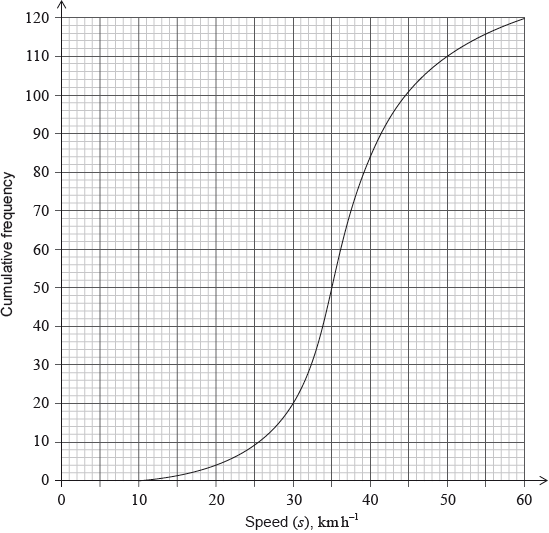
Estimate the minimum possible speed of one of these vehicles passing the hospital gate.[1]
Find the median speed of the vehicles.[2]
Write down the \({75^{{\text{th}}}}\) percentile.[1]
Calculate the interquartile range.[2]
The speed limit past the hospital gate is \(50{\text{ km}}\,{{\text{h}}^{ – 1}}\).
Find the number of these vehicles that exceed the speed limit.[2]
The table shows the speeds of these vehicles travelling past the hospital gate.
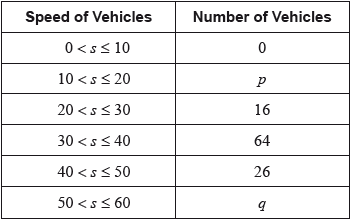
Find the value of \(p\) and of \(q\).[2]
The table shows the speeds of these vehicles travelling past the hospital gate.

(i) Write down the modal class.
(ii) Write down the mid-interval value for this class.[2]
The table shows the speeds of these vehicles travelling past the hospital gate.

Use your graphic display calculator to calculate an estimate of
(i) the mean speed of these vehicles;
(ii) the standard deviation.[3]
It is proposed that the speed limit past the hospital gate is reduced to \(40{\text{ km}}\,{{\text{h}}^{ – 1}}\) from the current \(50{\text{ km}}\,{{\text{h}}^{ – 1}}\).
Find the percentage of these vehicles passing the hospital gate that do not exceed the current speed limit but would exceed the new speed limit.[2]
Answer/Explanation
Markscheme
\(10{\text{ (km}}\,{{\text{h}}^{ – 1}})\) (A1)
\(36\) (G2)
\(41.5\) (G1)
\(41.5 – 32.5\) (M1)
\( = 9{\text{ (}} \pm {\text{1)}}\) (A1)(ft)(G2)
Notes: Award (M1) for quartiles seen. Follow through from part (c).
\(120 – 110\) (M1)
\( = 10\) (A1)(G2)
Note: Award (M1) for \(110\) seen.
\(p = 4\;\;\;q = 10\) (A1)(ft)(A1)(ft)
Note: Follow through from part (e).
(i) \(30 < s \leqslant 40\) (A1)
(ii) \(35\) (A1)(ft)
Note: Follow through from part (g)(i).
(i) \(36.8{\text{ (km}}\,{{\text{h}}^{ – 1}})\;\;\;(36.8333)\) (G2)(ft)
Notes: Follow through from part (f).
(ii) \(8.85\;\;\;(8.84904 \ldots )\) (G1)(ft)
Note: Follow through from part (f), irrespective of working seen.
\(\frac{{26}}{{120}} \times 100\) (M1)
Note: Award (M1) for \(\frac{{26}}{{120}} \times 100\) seen.
\( = 21.7{\text{ (}}\% )\;\;\;\left( {21.6666 \ldots ,{\text{ }}21\frac{2}{3},{\text{ }}\frac{{65}}{3}} \right)\) (A1)(G2)
Question
Daniel grows apples and chooses at random a sample of 100 apples from his harvest.
He measures the diameters of the apples to the nearest cm. The following table shows the distribution of the diameters.

Using your graphic display calculator, write down the value of
(i) the mean of the diameters in this sample;
(ii) the standard deviation of the diameters in this sample.[3]
Daniel assumes that the diameters of all of the apples from his harvest are normally distributed with a mean of 7 cm and a standard deviation of 1.2 cm. He classifies the apples according to their diameters as shown in the following table.
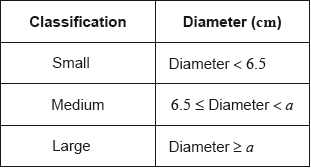
Calculate the percentage of small apples in Daniel’s harvest.[3]
Daniel assumes that the diameters of all of the apples from his harvest are normally distributed with a mean of 7 cm and a standard deviation of 1.2 cm. He classifies the apples according to their diameters as shown in the following table.

Of the apples harvested, 5% are large apples.
Find the value of \(a\).[2]
Daniel assumes that the diameters of all of the apples from his harvest are normally distributed with a mean of 7 cm and a standard deviation of 1.2 cm. He classifies the apples according to their diameters as shown in the following table.

Find the percentage of medium apples.[2]
Daniel assumes that the diameters of all of the apples from his harvest are normally distributed with a mean of 7 cm and a standard deviation of 1.2 cm. He classifies the apples according to their diameters as shown in the following table.

This year, Daniel estimates that he will grow \({\text{100}}\,{\text{000}}\) apples.
Estimate the number of large apples that Daniel will grow this year.[2]
Answer/Explanation
Markscheme
(i) \(6.76{\text{ (cm)}}\) (G2)
Notes: Award (M1) for an attempt to use the formula for the mean with a least two rows from the table.
(ii) \(1.14{\text{ (cm)}}\;\;\;\left( {1.14122 \ldots {\text{ (cm)}}} \right)\) (G1)
\({\text{P}}({\text{diameter}} < 6.5) = 0.338\;\;\;(0.338461)\) (M1)(A1)
Notes: Award (M1) for attempting to use the normal distribution to find the probability or for correct region indicated on labelled diagram. Award (A1) for correct probability.
\(33.8(\% )\) (A1)(ft)(G3)
Notes: Award (A1)(ft) for converting their probability into a percentage.
\({\text{P}}({\text{diameter}} \geqslant a) = 0.05\) (M1)
Note: Award (M1) for attempting to use the normal distribution to find the probability or for correct region indicated on labelled diagram.
\(a = 8.97{\text{ (cm)}}\;\;\;(8.97382 \ldots )\) (A1)(G2)
\(100 – (5 + 33.8461 \ldots )\) (M1)
Note: Award (M1) for subtracting “\(5+\) their part (b)” from 100 or (M1) for attempting to use the normal distribution to find the probability \({\text{P}}\left( {6.5 \leqslant {\text{diameter}} < {\text{their part (c)}}} \right)\) or for correct region indicated on labelled diagram.
\( = 61.2(\% )\;\;\;\left( {61.1538 \ldots (\% )} \right)\) (A1)(ft)(G2)
Notes: Follow through from their answer to part (b). Percentage symbol is not required. Accept \(61.1(\%)\) (\(61.1209\ldots(\%)\)) if \(8.97\) used.
\(100\,000 \times 0.05\) (M1)
Note: Award (M1) for multiplying by \(0.05\) (or \(5\%\)).
\( = 5000\) (A1)(G2)
